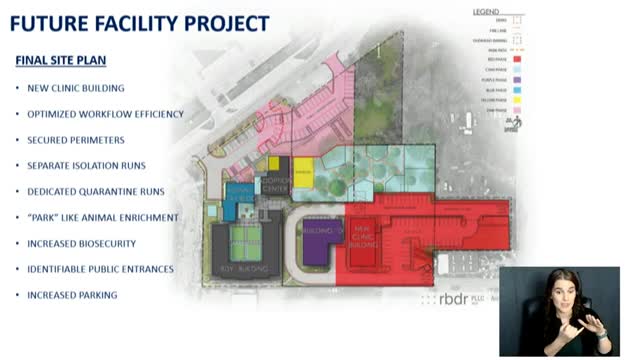Shelter faces crisis as animal intakes surge again
September 04, 2024 | Waco, McLennan County, Texas
This article was created by AI summarizing key points discussed. AI makes mistakes, so for full details and context, please refer to the video of the full meeting. Please report any errors so we can fix them. Report an error »

In a recent government meeting, officials discussed the ongoing challenges faced by the local animal shelter, particularly in light of a distemper outbreak in 2022 that necessitated the closure of 16 kennel runs. This temporary quarantine has strained the shelter's capacity and operations, prompting calls for a more sustainable solution.
The shelter's average monthly kennel occupancy for dogs has reached a maximum of 189, with a target occupancy rate of 80% recommended by experts to mitigate the risk of disease outbreaks. Alarmingly, 27 out of the last 30 months have seen the shelter exceed this capacity, raising concerns about animal welfare and the quality of care provided.
Despite a 30% decrease in overall animal intake, largely due to the shelter's temporary closure during the outbreak, the shelter continues to face resource strains. The average length of stay for animals has slightly decreased to 48 days in 2024, yet remains higher than in previous years and compared to other local shelters. Longer stays can lead to increased stress and health issues for the animals, complicating their adoption prospects.
Officials highlighted the importance of community engagement in reducing shelter intake. Strategies discussed included increasing funding for spay and neuter programs, as well as implementing trap-neuter-release initiatives for community cats. These measures aim to stabilize local animal populations and alleviate pressure on the shelter.
The meeting also underscored the need for public awareness regarding lost pets, noting that a significant percentage of animals are found close to their homes. Educational efforts are crucial, particularly in underserved communities, to improve the return-to-owner rates, which currently stand at approximately 11%.
As the shelter navigates these challenges, officials remain committed to enhancing animal welfare and operational efficiency, emphasizing the importance of community support and responsible pet ownership.
The shelter's average monthly kennel occupancy for dogs has reached a maximum of 189, with a target occupancy rate of 80% recommended by experts to mitigate the risk of disease outbreaks. Alarmingly, 27 out of the last 30 months have seen the shelter exceed this capacity, raising concerns about animal welfare and the quality of care provided.
Despite a 30% decrease in overall animal intake, largely due to the shelter's temporary closure during the outbreak, the shelter continues to face resource strains. The average length of stay for animals has slightly decreased to 48 days in 2024, yet remains higher than in previous years and compared to other local shelters. Longer stays can lead to increased stress and health issues for the animals, complicating their adoption prospects.
Officials highlighted the importance of community engagement in reducing shelter intake. Strategies discussed included increasing funding for spay and neuter programs, as well as implementing trap-neuter-release initiatives for community cats. These measures aim to stabilize local animal populations and alleviate pressure on the shelter.
The meeting also underscored the need for public awareness regarding lost pets, noting that a significant percentage of animals are found close to their homes. Educational efforts are crucial, particularly in underserved communities, to improve the return-to-owner rates, which currently stand at approximately 11%.
As the shelter navigates these challenges, officials remain committed to enhancing animal welfare and operational efficiency, emphasizing the importance of community support and responsible pet ownership.
View full meeting
This article is based on a recent meeting—watch the full video and explore the complete transcript for deeper insights into the discussion.
View full meeting
